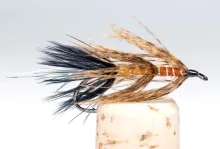I had the distinct pleasure of meeting the Danish shoreline fly fisher Peter Loevendahl, who is a discrete man. He goes around quietly in his native western Seeland and catches fish. A lot of fish.
Also notice this very thorough article on The Magnus and Fred Clan

A pattern no sea trout fisher should be without
I had the distinct pleasure of meeting the Danish shoreline fly fisher Peter Loevendahl, who is a discrete man. He goes around quietly in his native western Seeland and catches fish. A lot of fish.
When asked what fly he uses to catch all these fish, has says: 'The Grey Frede'.
If you then ask what he uses for his winter fishing, he says: 'The Grey Frede'.
An how about the fishing in the summer nights...? Well, the reader has probably already guessed the answer to that.
The Grey Frede is an arcetypical Danish shoreline fly. It's a classic, which has caught a lot of fish, and has been copied in numerous variations. The kindship with flies such as Magnus and Bjarke along with a lot of other Danish flies is obvious. Peter himself ties the fly in grey and green (olive). Apart from that he's quite conservative. A glimpse into his fly boxes is like looking under a bed: grey in grey.
I'm a big fan of naturally colored salt water flies, and Peter's Grey Frede is now a resident in my shoreline flybox.
See the Grey and Black Frede side by side.
Materials
| Hook | Partridge Nymph/Emerger, niflor, 2-4 |
| Thread | Peter uses kevlar. Less can do. |
| Tail | A few straws of Crystal Flash in a light green color and a grizzly marabou feather. 1/2 hook length |
| Body | Thick layer of grizzly marabou dubbing - very thick |
| Rib | Copper wire, fairly thick |
| Hackle | Grizzly bodyhackle |
| Eyes | bead chain eyes on top of hook |
| Head | Marabou dubbing over the eyes and a small head from tying thread |

Tying instructions
- Put the hook in the vice and straighten it a bit. The hook gap has to be enlarged a bit. The finished hook looks much like a slightly curved Limerick hook.
- Tie in flash on top of the hook bend
- Find a dense marabou feather and use the tip to make a flat tail. Leave the surplus as a base for the body
- Tie in a length of copper thread at the hook bend
- Cut of the barbs from a handfull of marabou feathers and mix them well
- Wax the tying thread and dub it with marabou in a thick layer
- Turn the dubbing over the hook to form a compact but fluffy body
- Let the dubbing stop approx. 1/3 from the eye
- Tie in a grizzly hackle in front of body. Dry fly type is best.
- Wind the hackle to the rear end of the body
- Lock down the hackle with the copper thread. Wind it opposite the hackle over the body
- Tie down copper thread and cut surplus
- Tie a couple of bead chain eyes on top of hook shank in front of body
- Dub the thread again and form a large soft head over and in front of the eyes
- Form a small head from thread, whip finish and varnish
- Stroke the whole fly lightly with a brush.
I prefer a more subtle approach. 6/0 thread and varnish will do.
- Log in to post comments








Grey Frede
The Grey Frede has worked like a dream here in upstate New York on brown trout, although I am tying the fly with a single nickel bead head. Thank you. The Europeans taught us a whole new, more effective way of nymph fishing. Now you're doing the same with this streamer. I have one question: Does Peter fish the Grey Frede with a loop knot?
Gra Frede
I just caught 7 brown trout here in upstate New York on the Gra Frede, size 8. Thank you Peter, again.